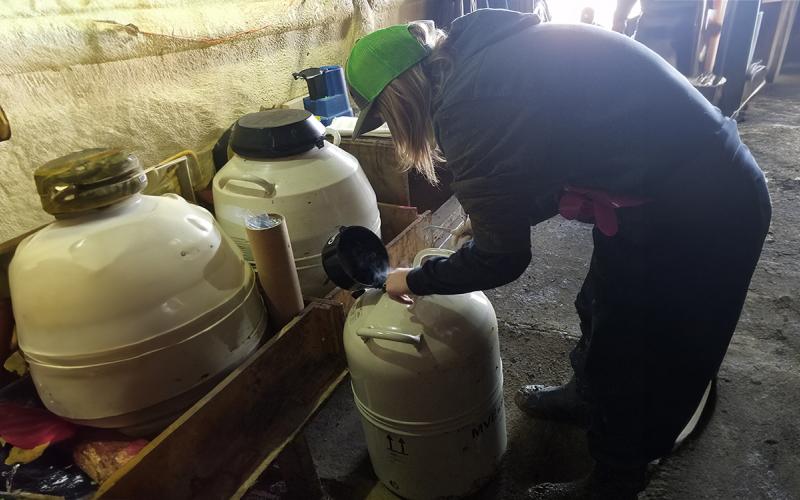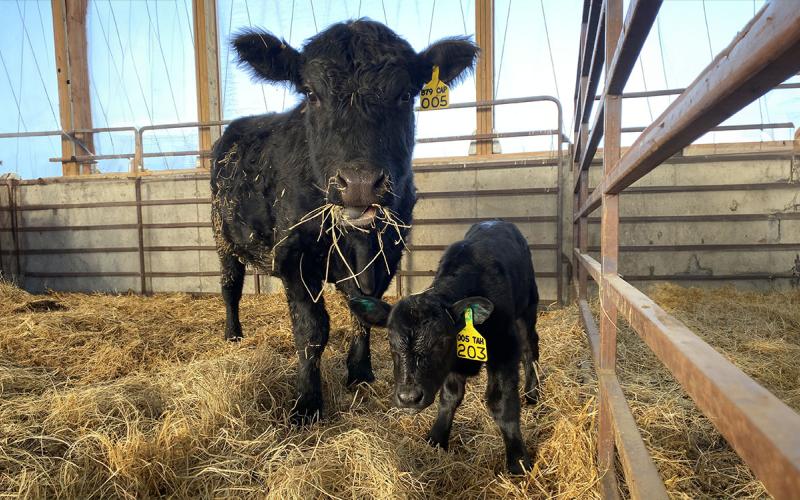Originally written by Grady Ruble, former SDSU Extension Cow/Calf Field Specialist.
Dr. Robbi Pritchard compared replacement females to corn farming in a recent producer meeting. His point being grain farmers don’t plant conventional corn when there are hybrid varieties that offer greater production potential, so why are we trending toward largely straight-bred cow herds and passing on the benefits of heterosis? This point provided the stimulus to revisit the topic and discuss the usefulness of heterosis along with breed complementarity.
About Heterosis
Heterosis is not new to the livestock industry and its benefits have been well documented. Heterosis comes in three different forms: individual, maternal, and paternal. Bourdon (2000) explains that retained heterosis is the increase in performance of crossbred progeny relative to that of its purebred parents. Maternal heterosis is the increase in production of a cow above that of the average of her parent breeds. Advantages of maternal heterosis are seen in maternal ability, reproduction, longevity, calf survivability, pounds of calf weaned and younger age at puberty. Paternal heterosis is similar to maternal heterosis in that it is the genetic advantage provided by the sire; benefits are also seen as increased bull fertility.
Lowly heritable traits
Heterosis offers an array of advantages but its greatest impact is seen in lowly heritable traits. Heritability is the proportion of variation observed in animals due to genetics passed along generations and the phenotypic variation observed due to genetic and environmental effects (Weaber, 2005). Examples of lowly heritable traits are reproduction, longevity, maternal ability and health. Lowly heritable traits respond slowly to selection since the greatest amount of variation in the traits are due to environment rather than genetics. Heterosis is an effective way to improve these lowly heritable traits (Weaber, 2005).
Breed Complementarity
Breeds are complementary to each other when one breed excels in certain traits the other breed does not and vice versa. If a successful mating is chosen the resulting progeny offer greater levels of performance in more traits than their straight-bred parents (Weaber and Spangler, 2013). Essentially, one would be using the strengths of one breed to offset the weaknesses of another (Gosey, 1991). Weaber and Spangler (2013) provide an example of the usefulness of breed complementarity in terms of matching cattle genetically to their environment and the resulting progeny to the marketplace. In the situation of a herd composed of crossbred Angus-Hereford cows mated to a Charolais bull, the crossbred cow offers the maternal capability along with carcass quality advantages while the Charolais bull will increase growth and carcass yield of his progeny. Thus, the maternally focused cow is a good fit for her environment and the high-growth calf can bring greater value to the marketplace.
System Considerations
There are a variety of breeding systems that can effectively capture the benefits of heterosis. To better illustrate these systems and their advantages see Table 1 below. The improvements in production associated with heterosis are substantial, which raises the question of why cross-breeding is not more widely adopted? One conclusion is that some of these crossbreeding systems do not fit a common-sense ranch management plan (Gosey, 2005). The average herd size in the United States is 40 cows (USDA, 2018) which creates a barrier for many producers where herd size is limiting their ability to utilize a crossbreeding system. Furthermore, management of breeding systems where multiple breeding pastures is required poses another obstacle. Another limiter, in an attempt to produce cattle that fall within the parameters of branded beef programs, many producers have trended toward straight-bred herds (Gosey, 2005).
The shortcoming of operating with largely straight-bred cows is it overlooks the advantages of crossbreeding resulting in the cumulative effect of heterosis being lost. If the cows are crossbred, every animal on the ranch is impacted by heterosis, which is a value that can be captured every year regardless of how the calves are marketed (Weaber, 2015). The added value due to heterosis is not subject to change like other branded beef programs, which makes the “premium” for heterosis very impactful.
Table 1. Production improvements and management considerations associated with crossbreeding systems and heterosisa |
|||
|---|---|---|---|
| System | Increase in weight weaned/cow exposed, % | Number of breeding pastures | Minimum herd size |
| Straight-bred | 0 | 1 | Any |
| Two-breed rotation | 16 | 2 | 50 |
| Three-breed rotation | 20 | 3 | 75 |
| Rotational terminal | 21 | 3 | 100 |
| Composite | 12-17 | 1 | Any |
| Purchased crossbreds with terminal sire | 24 | 1 | Any |
| a From (Weaber, 2010) | |||
Literature Cited:
- Bourdon, R. M. 2000. Mating strategies based on animal performance: random and assortative mating. In: K. Linsner, M. Carnis and L. Harvey, editors, Understanding animal breeding, second ed. Charles E. Stewart, Jr. , Prentice Hall Englewood Cliffs, NJ. p. 325-332.
- Gosey, J. 2005. Crossbreeding the forgotten tool. In: Range Beef Cow Symposium, Rapid City, SD. p 32.
- Gosey, J. A. 1991. Crossbreeding systems and the theory behind composite breeds. In: Proceedings of the Range Beef Cow Symposium XII, Ft. Collins, CO. p 33-35.
- USDA. 2018. Sector at a glance (Accessed 6/28 2018).
- Weaber, B. 2010. Crossbreeding for commercial beef production. In: M. K. Neilsen, editor, Beef Sire Selection Manual 2nd Edition. National Beef Cattle Consrtium p. 50-57.
- Weaber, B., and M. Spangler. 2013. Crossbreeding-One of the Tools to Increase Profitability. In: Beef Improvement Federation Research Symposium & Annual Meeting, Oklahoma City, OK.
- Weaber, R. 2015. Crossbreeding Strategies: Including Terminal vs. Maternal Crosses. In: Proc. Range Beef Cow Symp. XXXIV, Loveland, CO. p 117-130.
- Weaber, R. L. B. 2005. Considering Crossbreeding? Forage Systems Update 14(4)


